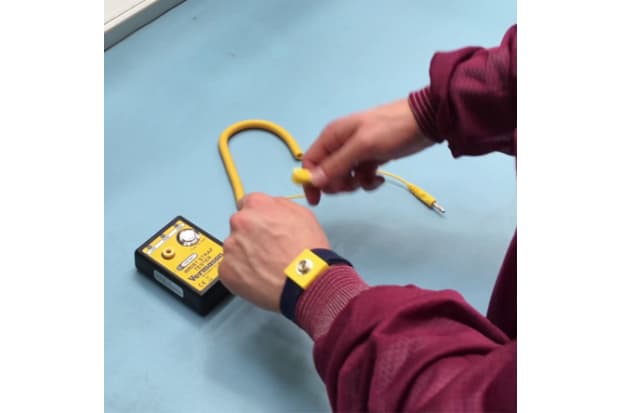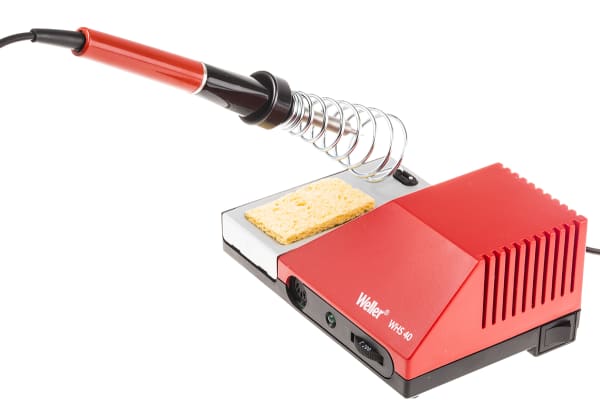- Published 18 Apr 2023
- Last Modified 29 Aug 2023
- 6 min
What is a Soldering Station?
This guide will outline the different elements you need to build a professional soldering station, how best to use it and when you should consider one over a soldering iron.

A soldering station is a device that’s used to assemble or repair complex electronic systems. Industrial soldering stations make this easier by providing tight control over temperatures and the choice of a variety of tools.
Parts of a Soldering Station
If you’re trying to put together the best soldering station for your needs, then knowing the exact tools and accessories you need to build one is a good starting point.

Main Control Unit
This is the station of the soldering station. It’s the element that controls the amount of energy that’s sent to the soldering pencil and therefore the temperature of the soldering tip and material. There are two types of main control units available:
- Analogue: on these control units, the temperature is set by turning a knob. The pencil’s heating element is fed power until the tip reaches the set temperature. At this point, the power is cut off automatically. If the tip temperature falls below the set level, the power will be turned back on again
- Digital: within digital control units, a Proportional–Integral–Derivative (PID) controller regulates the temperature of a soldering tip in real time. Often controlled via an LED display, the calibrated microprocessor within these units enables high levels of accuracy and responsiveness within the soldering tip’s temperature
The main control unit is the main purchase you’ll make for your soldering station, so it’s worth taking some time to look up reviews, consider options, and make sure you choose one with a good warranty and high levels of reliability. Looking for specific features such as performance wattage and energy-saving modes will also ensure the unit you choose makes the most of the electrical power it's using, helping to keep your power costs low.
What are Temperature-Controlled Soldering Stations?
Temperature-controlled soldering stations are another name for digital main control units. They have this name because they have adjustable temperature ranges that users can select depending on their needs. This allows for greater efficiency and accuracy within their soldering work, particularly on sensitive electronic components.

Soldering Pencil
As the element that applies the soldering material onto the electronic component, it’s key that you choose the right type of soldering pencil for your needs. When choosing your pencil, you need to make sure it's compatible with the type of material you’re going to use (specifically whether it’s lead-free or not) as well as the shape of tips most suitable for your application.
To enhance your level of control and accuracy, you may want to choose specialist soldering pencils. Some pencils also include automatic solder feeders, which means users can use just one hand to complete their task.
Foam Grip
Hand soldering involves working closely with very hot materials (sometimes up to more than 300°C) for extended periods of time. Although any user should be using gloves when soldering, having a foam grip on a soldering pencil will give greater protection and make detailed or extended work more comfortable.
Other essential accessories that will help to keep workers safe include a support rack on which the pencil can be rested in between soldering. This will ensure soldering material isn’t left everywhere or become a fire hazard on the workbench. Having a cleaning sponge nearby also means you can clean your iron quickly.

ESD Protection
To prevent damage to components and users, choosing a soldering station with electrostatic discharge (ESD) protection is recommended. Made from insulative plastic and conductive materials, these units prevent the build-up of static charges that could prove dangerous to a solderer or the components they’re working on.
If you work regularly on SMDs, integrated circuits (ICs), or semiconductors, having this protection is recommended as these boards and components are particularly sensitive to static electricity.
Desoldering Tools
Even if you’ve been soldering for a long time, accidents or mistakes can happen. Having desoldering tools close by means you can quickly correct a problem before it becomes fixed in place. These tools include SMD tweezers, which are designed to remove SMD chips, and hot air pencils which push hot air onto a component, making desoldering easier.
How to Use Soldering Stations
Once you’ve got your soldering station set up in place, following these steps will make sure you’re ready to solder safely and efficiently:
- Start with safety: the first step should always be to prepare the space and put on appropriate personal protective equipment (PPE) such as gloves, glasses and long sleeves. Making sure all the tools you need, such as desoldering tools, support racks and a sponge, are close by and that anything flammable or potentially dangerous is removed from the workbench will enable you to work safely
- Get a clean soldering tip: as well as choosing a soldering tip that’s the right size and shape for your needs, making sure it’s completely clean will stop any dangerous or damaging particulates from entering your electronic components
- Select a temperature: whether you’re using a digital or analogue main control unit, you need to set the right temperature for your task. This is usually done by turning a dial or adjusting the controls on a digital display
- Add soldering material: once the tip has reached the right temperature, add your soldering material of choice to it. Make sure you don’t have too much excess, as this will cause problems when you start your detailed work
- Begin the assembly or repair: using the pencil at an angle and maintaining the right amount of material on the tip will help you to achieve a good solder. The final product shouldn’t have any gaps or cracks and leave a visible glossy line
Soldering Stations vs Soldering Irons
When you’re making a decision whether to purchase a soldering station or iron, there are a few differences between the two options which you need to keep in mind:
- Level of temperature control: with an iron, the temperature is set at one level, meaning you need different irons for different jobs. In contrast, soldering stations allow the temperature to be quickly adjusted depending on the task. Plus digital soldering stations tightly control the temperature, allowing for greater accuracy
- Available workspace: stations are much larger than irons, especially with all the accessories and tools you require to work efficiently and safely. So if you have limited amounts of workspace, an iron might be a better option
- Size of the job: while soldering irons are great for quick jobs on components such as printed circuit boards (PCBs), stations are preferable for repetitive work on large circuit boards. This is because stations allow users to stop, start and adjust their tasks without having to switch the whole system off, making their work safer and more efficient
Further Reading
Related links
- RS PRO Analogue Soldering Station 65W, 230V 480°C
- RS PRO Soldering Station 90W, 220V
- RS PRO Soldering Station 700W, 220 → 240V
- Metcal Soldering Station 70W, 240V
- Metcal Soldering Station 80W, 100 → 240V
- RS PRO Soldering Station 60W, 220 → 240V
- Weller Soldering Station 70W, 230V
- Weller Soldering Station 200W, 230V


